Full Length Research Paper
ABSTRACT
The global quest for a sustainable bio-economy has brought to the fore importance of engaging agricultural systems in the production and in practice change. There have been issues limiting farmers from improving the practice of manure management as smart climate technology. The objective of this paper was to highlight the constraints, type, and valuation of manure types and information sources that smallholder dairy farmers find it useful to change practices regarding manure management. In this present study, 336 smallholder dairy farmers were surveyed on various constraints the farmers faced and, on the type, and value of different manure types and information on manure management received by the farmers. The study used descriptive statistics for the variables and compared them using frequency tables. The key findings from this study would support information to stakeholders in inducing climate-smart manure management practices as a climate adaptation practice. The study highlights the type of information systems that determine areas for further investigation as drivers of practice change for smallholder dairy farmers. The paper focuses on these constraints and synthesizes them into factors that determine practice change on manure management by smallholder dairy farmers in order to improve manure management.
Key words: Manure management, agricultural information, smallholder dairy farmers, practice change, information value.
INTRODUCTION
The global quest for a sustainable bio-economy has brought to the fore importance of engaging agricultural systems in production and in practice change by farmers (Adeyemo et al., 2019; Ribaudo et al., 2014; Tanner et
al., 2001). Climate-smart agriculture (CSA) has been named as a new approach to guide farmers to the needed changes in agricultural systems that can address food security and climate change (FAO, 2013). This use of CSA’s approach has been realized partly through targeted farmer information to the extension workers, subsequently reaching the targeted farmers (Ndambi et al., 2019; Snapp et al., 2002; Staal et al., 2002). In Sub-Saharan agricultural areas, smallholder farmers being the majority, have a need for agricultural information with them facing many challenges in production (Almagro and Martínez-Mena, 2014; Tanner et al., 2001). These smallholder farmers have been described as mixed farmers due to their wide variety of economic activities (Chagunda et al., 2016; Marenya et al., 2012). There is the use of manure from the dairy livestock on farms in smallholder mixed crop-livestock systems as a source of crop nutrients (Castellanos-Navarrete et al., 2015; Delve, 2001; Zake et al., 2010). Farm size and farm uses have been used to define smallholder farmers with few studies looking for other definition areas (Cohn et al., 2017; Herrero et al., 2014; Samberg et al., 2016). The common characteristic that smallholder farmers use manure leads to improved manure management as a key recommendation in many studies on smallholders (Paul et al., 2013; Rufino et al., 2006). The focus on improved manure management has also been observed as the potential to minimize greenhouse gasses emissions as well as also minimizing nutrient losses (Markewich et al., 2010; Pelster et al., 2016; Rosenstock et al., 2016).
The practice changes for various smallholder farmers have been observed to have constraints (Ongeri, 2014; Ouédraogo et al., 2017). The focus on the constraints is due to the realization that for smallholder farmers, climate change has and is causing them to experience challenges due to these demographic being highly susceptible to climate change impacts on weather patterns (Ara Parvin and Reazul Ahsan, 2013; Bellarby et al., 2014). There have been issues limiting smallholder farmers from improving the practice of manure management as smart climate technology. Few studies focus on these constraints as there is more research on ways to improve practices that lead to increased production by smallholder farmers (Gibbons et al., 2014; Zingore et al., 2007). The key drivers affecting smallholders farmers ability to manage and use manure on own farms as fertilizer that have been observed from studies to be land, labour, number of livestock, lack of knowledge, inadequate funds and level of education (Ilukor et al., 2019; Jolliffe, 2004; Lekasi et al., 2001; Mutoko et al., 2015; VanLeeuwen et al., 2012). This, however, has led to the observation of the need to use this and other variables to observe the key information drivers in terms of constraints that affect smallholder farmers from improving their manure management. Information is needed on community practices and perceptions to manure management, and this specifically needs to be focused on manure removal from livestock housing systems, barriers to manure handling, and source of awareness of farm practices (Lekasi et al., 2001; Waithaka et al., 2007). Different information on barriers to improvements in practices by smallholder farmers, aside from manure management practices and livestock housing need be assessed (Mutoko et al., 2015). Further studies have also been needed on community constraints and drivers of practice change for manure management by smallholder dairy farmers. Besides, just the knowledge of the constraints key should be to determine the value of information sources to these farmers.
This study seeks to derive the constraints to improved manure management and describe through analyses information sources to improved manure management by the smallholder dairy farmers in Nandi County. Therefore, the specific objectives were (i) to determine the constraints to improving manure management by smallholder dairy farmers, (ii) to determine the sources and value of these sources of information on manure management to the smallholder dairy farmers of Nandi County.
MATERIALS AND METHODS
Study area
The field study was conducted on smallholder dairy farmers within Nandi County, Kenya (0.565°N, 34.736°E, 0.565°N, 35.437°E, 35.437°E, 0.118°S, 34.736°E, 0.118°S). The mean annual temperatures range from 18- 22°C, with temperatures at lower elevations (<1400 m) going as high as 26°C. Altitude ranges from approximately 600 m a.s.l. in the South to over 2200 m a.s.l. in the Northeast of the county. The highlands are recognized for their high agricultural potential (GOK, 2015; Mudavadi et al., 2001). However, livestock and crop farming are mainly subsistence, with average land sizes of approximately 4.5 ha per household. Dairy production is common throughout the county, with tea as a major cash crop, and maize as the primary staple crop (GOK, 2015).
Field survey
This study utilized a household survey that was done using a questionnaire tool customized from the Integrated Modelling Platform for mixed Animal Crop systems (IMPACTlite). IMPACTlite was modified from IMPACT to collect household-level data detailed enough to capture within-site variability on key indicators of technical, socio-economic, and institutional constraints as well as evaluating the value of the different types of manure and information sources received and found effective by smallholder dairy farmers. The household questionnaire was completed through face-to-face interviews using the Open Data Kit (ODK) platform (ODK, 2017). In case of absence of the household head, the most senior member available or the household member responsible for the farm was interviewed. In the course of the actual household survey, after interviewing the first household, skipped the third, and interviewed the fourth household. This continued until the computed sample size was done. This was done to ensure quality data collection. The study population was the community in Nandi County, while the target population was the dairy cattle farmers households.
The unit of analysis was the household, and in order to get a good representative of the targeted population, the procedure and formula below were employed. The sample size was computed using the simple random sampling technique to draw a sample size of 400 respondents for the survey using Fischer's formula as described by Mugenda and Mugenda (2003).

Where n is the sample size, N is the targeted population (N= 41311 ï‚»7- adult population of Nandi County removing youth below 15 years 45% of total population (KNBS, 2010; NCPD, 2017) and e the desired confidence level (e=5%) of the sample population of 336 households. The population of Nandi County, which is 751129 (KNBS, 2010), removing 45% who are youth below the age of 15 (NCPD, 2017), gives 413117, which was considered the study population in the computation of the sample size. The confidence level was taken to be a 5% level of significance with the calculation shown. Random sampling points were generated using QGIS in the three Ago-Ecological Zones of Nandi County and distributed by a fraction of the land area (Figure 1). At each of the 36 random points, about 11 farmers were targeted and interviewed to generate a sample size of 396 households, of which 336 were interviewed. The actual study response rate was 84.8%. The data was found to be sufficient for analysis since it was above 80%, according to Babbie (2013), who considers a response rate above 70% to be very good. The dataset comprised household survey results where both descriptive and inferential statistics were performed using Base R Package (RStudio V 1.1.442) (Rstudio Team, 2016). The variables on constraints, awareness, and source of information on manure management were then analyzed using frequency tables and descriptive statistics.
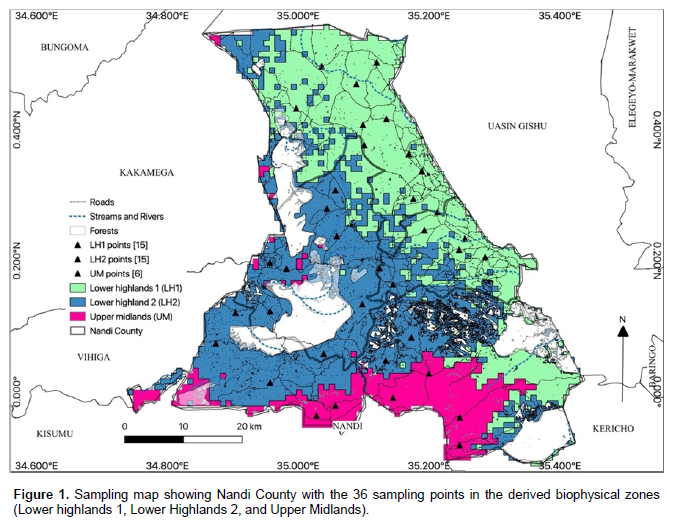
RESULTS AND DISCUSSION
Technical, socio-economic and institutional constraints
Technical and socio-economic constraints to farmers that hinder improvement to manure management were analyzed and shown in Table 1. The results of these constraints show that the lack of farm labour had a majority (52%) citing it as a very/ important factor limiting improved manure management. The constraint with the least important was the view that manure had too low benefits when used as fertilizer, compared to the benefits when used as a fuel (dung cakes) with 99% thinking it is not important/ irrelevant. An assessment of institutional constraints that affect the smallholder dairy farmers in Nandi County from improving manure management is tabulated in Table 2. The majority view lack of information to improve manure from institutions (85%), lack of access to available information (86%), lack of access to loans (63%), and lack of access to required equipment (53%) as major constraints.
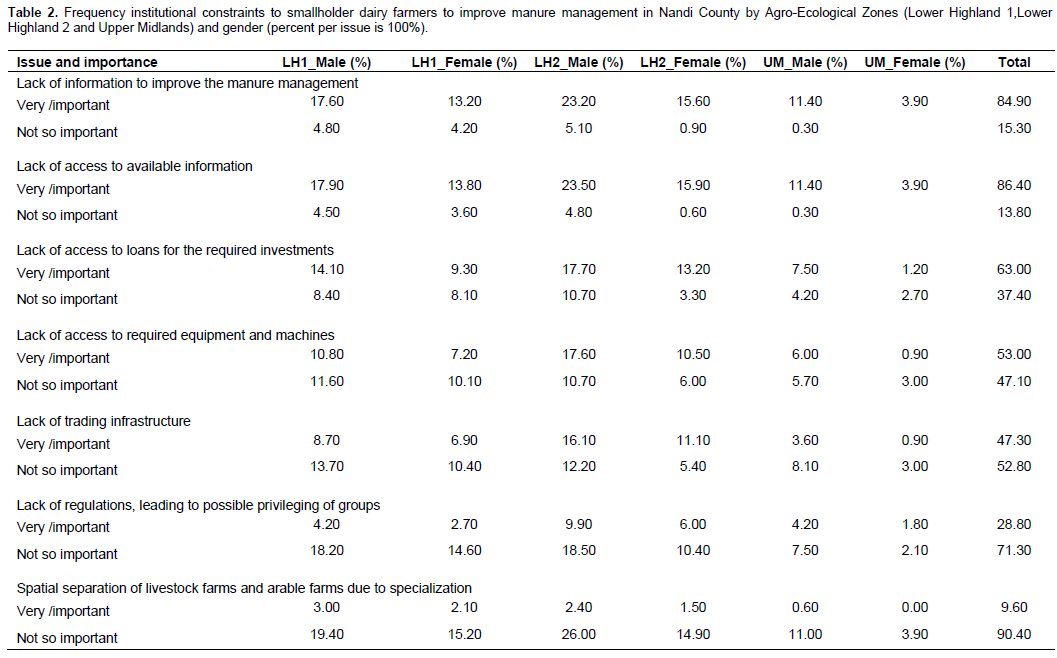
The study found similar observations to Mutoko et al. (2015) and Mwirigi et al. (2014) who all found the availability of funds to farmers as being major limiting factors to the improvement of farm practices. The results of this current study show that farmers, including smallholder farmers, do have an opinion on the constraints that affect their practice. That aside from lack of finances, these farmers is aware of related concerns to finance and that there are other constraints that have been highlighted. This observation is also alluded to in other studies to be a solution space (Greenhalgh et al., 2019; Ouédraogo et al., 2017). The expectation that institutions are the best way to offer solutions and extension, and this current study offers opportunities for the private sector to fill such gaps on information dissemination especially if backed up with financial support and incentives (Abebe et al., 2013; Jensen et al., 2019).
Smallholder farmers perception of the value of the type of manure as a fertilizer on own farm
Smallholder dairy farmers were assessed for the value of slurry from dairy cattle and from other animals. Slurry from dairy cattle (16%) was perceived very/important than from other livestock (8%) (Table 3). A similar analysis of farmers' perception of the importance of solid manure from dairy livestock and compared to other livestock is shown in Table 3. The majority (94%) thought solid storage from dairy cattle was very important. The farmers found solid manure from dairy cattle and other livestock very important with higher margins compared to slurry from similar livestock. The smallholder dairy farmers responded to being asked if they had spent any time/money in the last five years to improve manure management at their households. These results were tabulated in Table 4 below, where the majority (60%) of the smallholder dairy farmers spent time and money to improve manure treatment. Analysis of areas that these farmers spent time/money on in terms of manure collection, storage, treatment, transport, and the application was done and tabulated in Table 4. This table showed that the majority (96%) made improvements in terms of manure treatment with the same farmers' transportation and storage (both at 76%), manure collection (61%), and least was an application (57%).
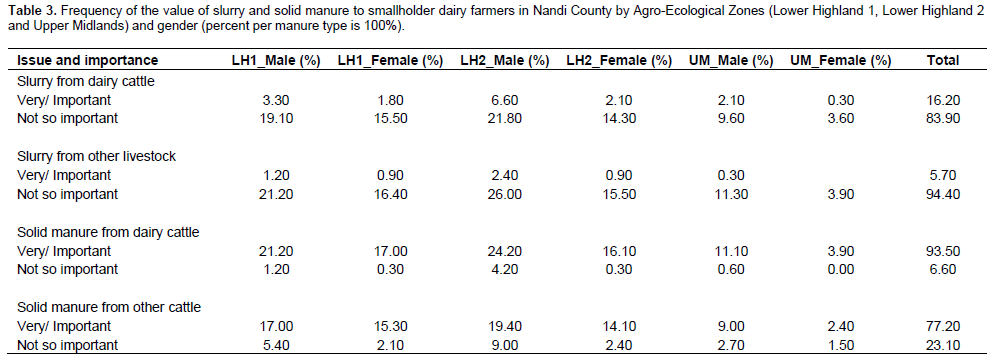
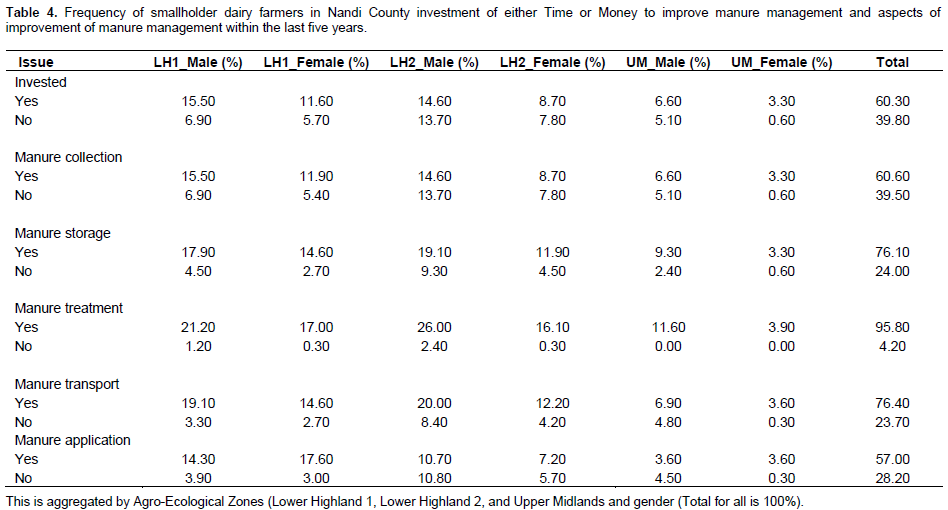
The importance of manure to farmers has been highlighted in many studies, especially the use of own farm manure to return nutrients (Diogo et al., 2013; van Wijk et al., 2009). Such studies also have shown how to improve productivity. This present study shows the focus of smallholder farmers on improving manure thus highlighting key gaps that can be filled in regard to improved manure management (Jensen et al., 2019; Van Der Wolf et al., 2019). The show that the farmers in this current study have spent money on improving their practices does show the willingness to pay and also awareness of challenges that these farmers go through.
Considerations to improve manure management
The reasons for these farmers' improving manure management were asked to the farmers, and the results categorized and tabulated in Table 5. The results focused on on-farm hygiene, water quality, odour from manure, nutrient improvement for crops, selling value, incentivization, and restriction from the government. The majority (38%) saying was very important was needed to improve manure to improve human and animal health. Restrictions and incentives from gov’t were not important/irrelevant (97 and 99%) as a reason to manage manure management (Table 5). This present study is in concurrence with studies on the perception of farmers to manure and its importance and thus the addition from this present study is the motivations for these farmers to improve manure is not just improvement of nutrition to crops (Navaratne et al., 2019; Odendo et al., 2009).

Information to improve manure management
The number of smallholder dairy farmers who received the information within the last five years on improving manure management were analysed and tabulated in Table 6. The table showed that the majority (80%) received information. Table 7 looked at the perception in the value of the information source on improving manure management. The table showed the smallholder farmers' value for other farmers' information led (12%) terms of the source of information to improve manure management. Table 8 analysed the media that influence farmers' behaviors in terms of manure management and these were tabulated by gender of the farmer and the AEZ that the farmer has. Local radio (75%) was very/important for manure management information for smallholder dairy farmers in Nandi County.

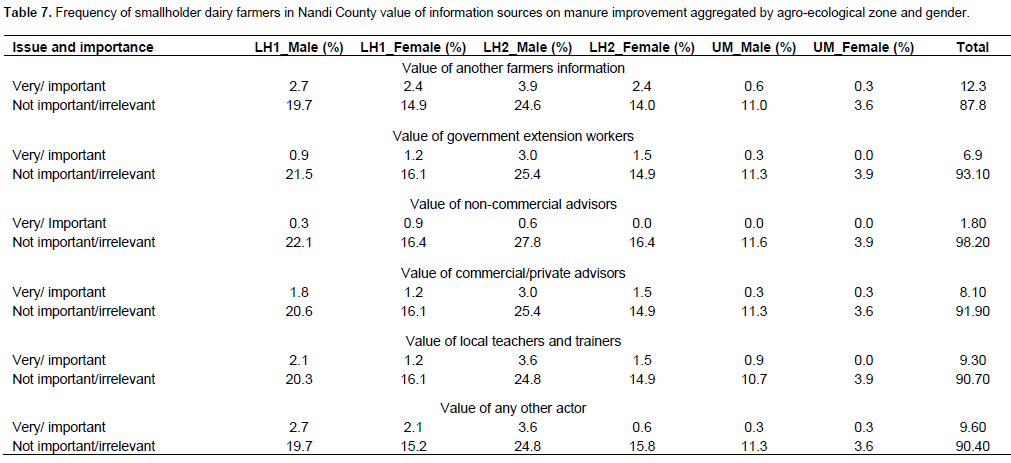
Billboards/posters were found to be least effective as a source of information on manure management. These findings were in concurrence with Mutoko et al. (2015) whose observations included increasing and motivating farmer trainers to train more groups and using diverse techniques lie field days and learning tours. Studies on information systems to farmers are varied in their focus, with most agreeing on the importance of agricultural information to farmers (Hochman et al., 2017; Kante et al., 2017; Makawia, 2018; Moglia et al., 2018). This study evaluation of the value of information and sources also agrees with such studies and also focuses on the smallholder farmers' perception of the sources of agricultural information and its value to them. The movement beyond just climate change as a key constraint is best demonstrated with knowledge of the value of farmers give to various sources of information (Maguire-Rajpaul et al., 2020). The findings from this present study disagree with other recent studies focusing on ICT as the next frontiers for farmer information being most beneficial, this study shows that smallholder farmers prefer medium that is more local thus these technologies would need to be localised (Hartmann et al., 2020; Mereu et al., 2018).
This study revealed that access to information on manure management was a major constraint to improving manure management. Those farmers sited lack of labour and lack of manure collection capacity as major technical and socio-economic constraints. The study also found a lack of information from institutions on manure management and lack of access to information on manure management as major important institutional constraints. The farmers also cited a lack of loans in terms of capital and lack of access to equipment and services for manure management in relation to installing biogas systems as major institutional constraints. These findings agreed with Chibanda et al. (2009); Mudavadi et al. (2001) and Waithaka et al. (2007) who also found that smallholders in these areas were initially major cash crop producers and by moving to milk the commercialization was of key importance with lack of institutions focussing on manure management, they also found labour availability is a constraint.
CONCLUSION AND RECOMMENDATIONS
The study demonstrated key constraints as access to information on manure management and manure collection capacity, which are subject to labour availability and financial capital for smallholder dairy farmers. The institutional constraints that matter most to these farmers were access to information on manure management, access to financial capital, and equipment and services for manure management. This creates a mix of agricultural and financial information that was preferred by smallholder dairy farmers. These farmers felt that such information would enable them to manage their manure better, thereby mitigating Greenhouse gas emissions while minimizing nutrient losses through managed manure.
CONFLICT OF INTERESTS
The authors have not declared any conflict of interests.
REFERENCES
|
Abebe GK, Bijman J, Kemp R, Omta O, Tsegaye A (2013). Contract farming configuration: Smallholders' preferences for contract design attributes. Food Policy 40:14-24. |
|
|
Adeyemo T, Amaza P, Okoruwa V, Akinyosoye V, Salman K, Abass A (2019). Determinants of intensity of biomass utilization: Evidence from cassava smallholders in Nigeria. Sustainability 11:9. |
|
|
Almagro M, Martínez-Mena M (2014). Litter decomposition rates of green manure as affected by soil erosion, transport and deposition processes, and the implications for the soil carbon balance of a rainfed olive grove under a dry Mediterranean climate. Agriculture, Ecosystems and Environment 196(1):167-177. |
|
|
Ara Parvin G, Reazul Ahsan SM (2013). Impacts of climate change on food security of rural poor women in Bangladesh. Management of Environmental Quality: An International Journal 24(6):802-814. |
|
|
Babbie E (2013). Social Inquiry: Ethics and Politics. In E. Mitchell, N. Albert, J. Chell, & M. Ortberg (Eds.), The Practice of Social Research (Thirteenth). Chapman University. |
|
|
Bellarby J, Stirling C, Vetter SH, Kassie M, Kanampiu F, Sonder K, Smith P, Hillier J (2014). Identifying secure and low carbon food production practices: A case study in Kenya and Ethiopia. Agriculture, Ecosystems and Environment 197:137-146. |
|
|
Castellanos-Navarrete A, Tittonell P, Rufino MC, Giller KE (2015). Feeding, crop residue and manure management for integrated soil fertility management - A case study from Kenya. Agricultural Systems 134:24-35. |
|
|
Chagunda MG, Mwangwela A, Mumba C, Dos Anjos F, Kawonga BS, Hopkins R, Chiwona-Kartun L (2016). Assessing and managing intensification in smallholder dairy systems for food and nutrition security in Sub-Saharan Africa. Regional Environmental Change 16(8):2257-2267. |
|
|
Chibanda M, Ortmann GF, Lyne MC (2009). Institutional and governance factors influencing the performance of selected smallholder agricultural cooperatives in KwaZulu-Natal. Agrekon 48(3):293-315. |
|
|
Cohn AS, Newton P, Gil JDB, Kuhl L, Samberg L, Ricciardi V, Manly JR, Northrop S (2017). Smallholder agriculture and climate change. Annual Review of Environment and Resources 42(1):347-375. |
|
|
Delve R (2001). Implications of livestock feeding management on soil fertility in the smallholder farming systems of sub-Saharan Africa. Agriculture, Ecosystems and Environment 84(3):227-243. |
|
|
Diogo RVC, Schlecht E, Buerkert A, Rufino MC, van Wijk MT (2013). Increasing nutrient use efficiency through improved feeding and manure management in urban and peri-urban livestock units of a West African city: A scenario analysis. Agricultural Systems 114:64-72. |
|
|
FAO (2013). Climate-Smart Agriculture Sourcebook. In Sourcebook on Climate-Smart Agriculture, Forestry and Fisheries. |
|
|
Gibbons JM, Williamson JC, Williams AP, Withers PJA, Hockley N, Harris IM, Hughes JW, Taylor RL, Jones DL, Healey JR (2014). Sustainable nutrient management at field, farm and regional level: Soil testing, nutrient budgets and the trade-off between lime application and greenhouse gas emissions. Agriculture, Ecosystems and Environment 188:48-56. |
|
|
GOK (2015). Nandi County Development Profile. Government of Kenya. |
|
|
Greenhalgh G, Alexander KS, Larson S, Thammavong P, Sacklokham S, Thephavanh M, Sinavong P, Moglia M, Perez P, Case P (2019). Transdisciplinary agricultural research in Lao PDR. Journal of Rural Studies 72:216-227. |
|
|
Hartmann G, Nduru G, Dannenberg P (2020). Digital connectivity at the upstream end of value chains: A dynamic perspective on smartphone adoption amongst horticultural smallholders in Kenya. Competition and Change. |
|
|
Herrero M, Thornton PK, Bernués A, Baltenweck I, Vervoort J, van de Steeg J, Makokha S, van Wijk MT, Karanja S, Rufino MC, Staal SJ (2014). Exploring future changes in smallholder farming systems by linking socio-economic scenarios with regional and household models. Global Environmental Change 24(1):165-182. |
|
|
Hochman Z, Horan H, Reddy DR, Sreenivas G, Tallapragada C, Adusumilli R, Gaydon D, Singh KK, Roth CH (2017). Smallholder farmers managing climate risk in India: 1. Adapting to a variable climate. Agricultural Systems 150:54-66. |
|
|
Ilukor J, Isoto RE, Turinawe A, Muwanika FR (2019). Do Investments in Agricultural Extension Deliver Positive Benefits to Health, Trade and Industry, Water and Environment ? International Journal of Agricultural Education and Extension 5(1):203-224. |
|
|
Jensen PF, Prowse M, Larsen MN (2019). Smallholders' demand for and access to private-sector extension services: A case study of contracted cotton producers in northern Tanzania. Journal of Agrarian Change 19(1):122-134. |
|
|
Jolliffe D (2004). The impact of education in rural Ghana: Examining household labor allocation and returns on and off the farm. Journal of Development Economics 73(1):287-314. |
|
|
Kante M, Oboko R, Chepken C (2017). ICTs' model for cereal farmers in the access and use of agricultural input information in developing countries : Questionnaire validation using SEM. American Journal of Information Systems 5(1):1-12. |
|
|
KNBS (2010). The National Population and Housing Census. In 2009 KNBS Census report. |
|
|
Lekasi JC, Tanner JC, Kimani SK, Harris PJC (2001). Manure management in the Kenya highlands: practices and potential. Second edition for high potential production system portfolio of the natural resources systems programme renewable natural resources knowledge strategy Vol. 2. |
|
|
Maguire-Rajpaul VA, Khatun K, Hirons MA (2020). Agricultural Information's Impact on the Adaptive Capacity of Ghana's Smallholder Cocoa Farmers. Frontiers in Sustainable Food Systems P. 4. |
|
|
Makawia PJ (2018). Agricultural information needs and their accesibility to sesame producers in Morogoro District, Tanzania [University of Agriculture]. |
|
|
Marenya P, Nkonya E, Xiong W, Deustua J, Kato E (2012). Which policy would work better for improved soil fertility management in sub-Saharan Africa, fertilizer subsidies or carbon credits? Agricultural Systems 110:162-172. |
|
|
Markewich HA, Pell AN, Mbugua DM, Cherney DJR, van Es HM, Lehmann J, Robertson JB (2010). Effects of storage methods on chemical composition of manure and manure decomposition in soil in small-scale Kenyan systems. Agriculture, Ecosystems and Environment 139(1-2):134-141. |
|
|
Mereu V, Santini M, Cervigni R, Augeard B, Bosello F, Scoccimarro E, Spano D, Valentini R (2018). Robust decision making for a climate-resilient development of the agricultural sector in Nigeria. In Natural Resource Management and Policy P. 52. |
|
|
Moglia M, Alexander KS, Thephavanh M, Thammavong P, Sodahak V, Khounsy B, Vorlasan S, Larson S, Connell J, Case P (2018). A Bayesian network model to explore practice change by smallholder rice farmers in Lao PDR. Agricultural Systems 164:84-94. |
|
|
Mudavadi PO, Otieno K, Wanambacha JW, Odenya JO (2001). Smallholder dairy production and marketing in western Kenya: A review of literature. |
|
|
Mugenda O, Mugenda A (2003). Research Methods: Quantitative and Qualitative Approaches. ACT, Nairobi. |
|
|
Mutoko MC, Rioux J, Kirui J (2015). Barriers, incentives and benefits in the adoption of climate-smart agriculture: Lessons from the MICCA pilot project in Kenya. |
|
|
Mwirigi J, Balana BB, Mugisha J, Walekhwa P, Melamu R, Nakami S, Makenzi P (2014). Socio-economic hurdles to widespread adoption of small-scale biogas digesters in Sub-Saharan Africa: A review. Biomass and Bioenergy 70:17-25. |
|
|
Navaratne NWMGS, Wanigasundera WADP, Alahakoon PCB (2019). Perceptions of Climate Change and Adaptation of Climate Smart Technology by the Tea Smallholders: A Case Study of Ratnapura District in Sri Lanka. Asian Journal of Agricultural Extension, Economics and Sociology 36(3):1-18. |
|
|
NCPD (2017). Kenya National Adolescents and Youth Survey (NAYS). |
|
|
Ndambi OA, Pelster DE, Owino JO, de Buisonjé F, Vellinga T (2019). Manure Management Practices and Policies in Sub-Saharan Africa: Implications on Manure Quality as a Fertilizer. Frontiers in Sustainable Food Systems 3:1-14. |
|
|
Odendo M, Obare G, Salasya B (2009). Factors responsible for differences in uptake of integrated soil fertility management practices amongst smallholders in western Kenya. African Journal of Agricultural Research 4(11):1303-1311. |
|
|
ODK (2017). Open Data Kit. |
|
|
Ongeri BO (2014). Small scale horticultural farming along the Kenyan highways and local economic development: Exploring the effect of factor prices. International Review of Research in Emerging Markets and the Global Economy 1(3):2311-3200. |
|
|
Ouédraogo M, Zougmoré R, Moussa AS, Partey ST, Thornton PK, Kristjanson P, Ndour NYB, Somé L, Naab J, Boureima M, Diakité L, Quiros C (2017). Markets and climate are driving rapid change in farming practices in Savannah West Africa. Regional Environmental Change 17(2):437-449. |
|
|
Paul S, Meer HD, Onduru D, Ebanyat P, Ergano K, Zake J, Wouters B, Gachimbi L, Keulen H (2013). Effects of cattle and manure management on the nutrient economy of mixed farms in East Africa : A scenario study. African Journal of Agricultural Research 8(41):5129-5148. |
|
|
Pelster DE, Gisore B, Goopy J, Korir D, Koske JK, Rufino MC, Butterbach-Bahl K (2016). Methane and nitrous oxide emissions from cattle excreta on an East African grassland. Journal of Environment Quality 45(5):1531. |
|
|
Ribaudo M, Savage J, Aillery M (2014). An Economic Assessment of Policy Options to Reduce Agricultural Pollutants in the Chesapeake Bay. United States Department of Agriculture. June. Economic Research Report No. (ERR-166) 73 pp. |
|
|
Rosenstock TS, Rufino MC, Butterbach-Bahl K, Wollenberg E, Richards M (2016). Methods for Measuring Greenhouse Gas Balances and Evaluating Mitigation Options in Smallholder Agriculture (T. S. Rosenstock, M. C. Rufino, K. Butterbach-Bahl, L. Wollenberg, & M. Richards (eds.)). Springer International Publishing. |
|
|
Rstudio Team (2016). RStudio - Open source and enterprise-ready professional software for R. RStudio. |
|
|
Rufino MC, Rowe EC, Delve RJ, Giller KE (2006). Nitrogen cycling efficiencies through resource-poor African crop-livestock systems. Agriculture, Ecosystems and Environment 112(4):261-282. |
|
|
Samberg LH, Gerber JS, Ramankutty N, Herrero M, West PC (2016). Subnational distribution of average farm size and smallholder contributions to global food production. Environmental Research Letters 11:12. |
|
|
Snapp SS, Rohrbach DD, Simtowe F, Freeman HA (2002). Sustainable soil management options for Malawi: Can smallholder farmers grow more legumes? Agriculture, Ecosystems and Environment 91(1-3):159-174. |
|
|
Staal SJ, Baltenweck I, Waithaka MM, DeWolff T, Njoroge L (2002). Location and uptake: Integrated household and GIS analysis of technology adoption and land use, with application to smallholder dairy farms in Kenya. Agricultural Economics 27(3):295-315. |
|
|
Tanner JC, Holden SJ, Owen E, Winugroho M, Gill M (2001). Livestock sustaining intensive smallholder crop production through traditional feeding practices for generating high quality manure-compost in upland java. Agriculture, Ecosystems and Environment 84(1):21-30. |
|
|
Van Der Wolf J, Jassogne L, Gram GIL, Vaast P (2019). Turning local knowledge on agroforestry into an online decision-support tool for tree selection in smallholders' farms. Experimental Agriculture 55(S1):50-66. |
|
|
van Wijk MT, Tittonell P, Rufino MC, Herrero M, Pacini C, Ridder N, Giller KE (2009). Identifying key entry-points for strategic management of smallholder farming systems in sub-Saharan Africa using the dynamic farm-scale simulation model Nuances-Farmsim. Agricultural Systems 102(1-3):89-101. |
|
|
VanLeeuwen JA, Mellish T, Walton C, Kaniaru A, Gitau R, Mellish K, Maina B, Wichtel J (2012). Management, productivity and livelihood effects on Kenyan smallholder dairy farms from interventions addressing animal health and nutrition and milk quality. Tropical Animal Health and Production 44(2):231-238. |
|
|
Waithaka MM, Thornton PK, Shepherd KD, Ndiwa NN (2007). Factors affecting the use of fertilizers and manure by smallholders: The case of Vihiga, western Kenya. Nutrient Cycling in Agroecosystems 78(3):211-224. |
|
|
Zake J, Tenywa JS, Kabi F (2010). Improvement of manure management for crop production in Central Uganda. Journal of Sustainable Agriculture 34(6):595-617. |
|
|
Zingore S, Murwira HK, Delve RJ, Giller KE (2007). Soil type, management history and current resource allocation: Three dimensions regulating variability in crop productivity on African smallholder farms. Field Crops Research 101(3):296-305. |
|
Copyright © 2024 Author(s) retain the copyright of this article.
This article is published under the terms of the Creative Commons Attribution License 4.0